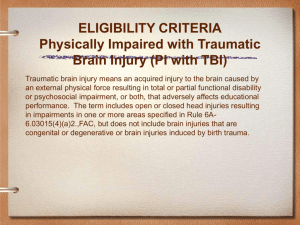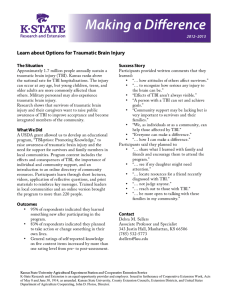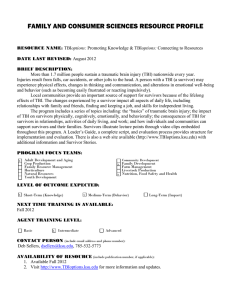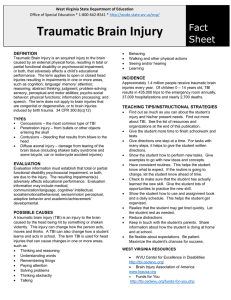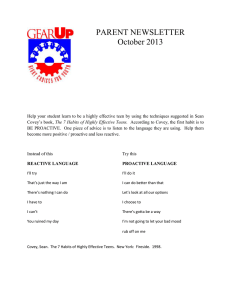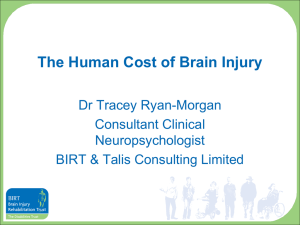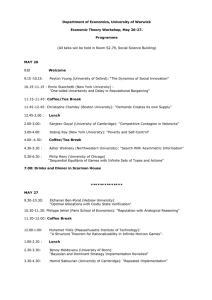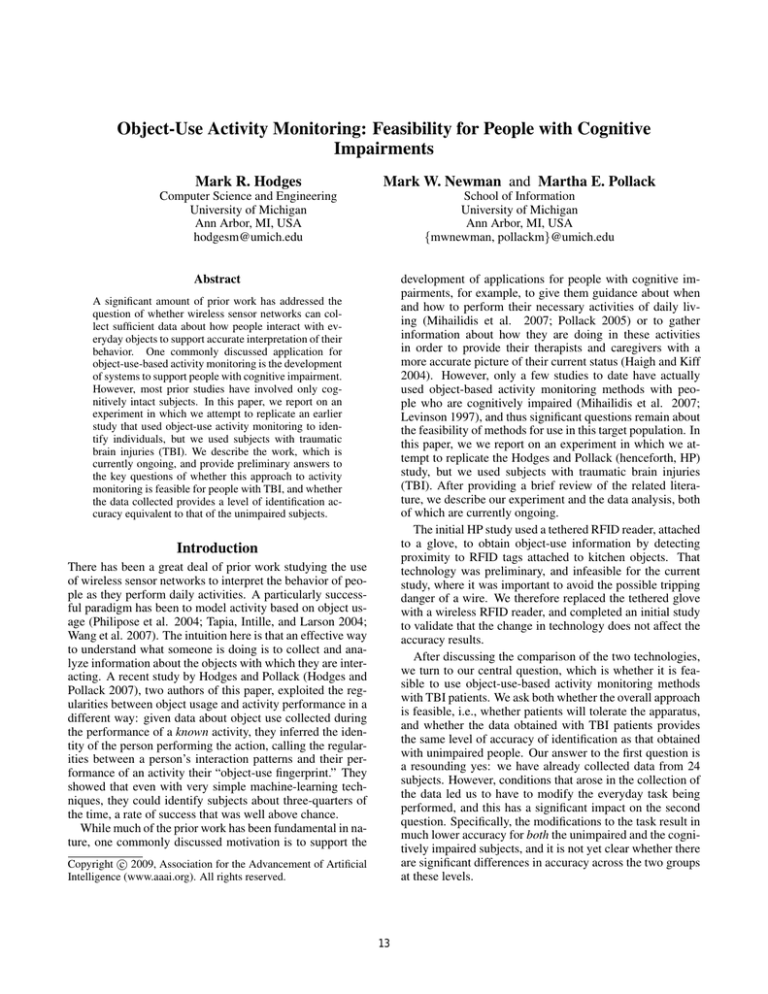
Object-Use Activity Monitoring: Feasibility for People with Cognitive
Impairments
Mark R. Hodges
Mark W. Newman and Martha E. Pollack
Computer Science and Engineering
University of Michigan
Ann Arbor, MI, USA
hodgesm@umich.edu
School of Information
University of Michigan
Ann Arbor, MI, USA
{mwnewman, pollackm}@umich.edu
development of applications for people with cognitive impairments, for example, to give them guidance about when
and how to perform their necessary activities of daily living (Mihailidis et al. 2007; Pollack 2005) or to gather
information about how they are doing in these activities
in order to provide their therapists and caregivers with a
more accurate picture of their current status (Haigh and Kiff
2004). However, only a few studies to date have actually
used object-based activity monitoring methods with people who are cognitively impaired (Mihailidis et al. 2007;
Levinson 1997), and thus significant questions remain about
the feasibility of methods for use in this target population. In
this paper, we we report on an experiment in which we attempt to replicate the Hodges and Pollack (henceforth, HP)
study, but we used subjects with traumatic brain injuries
(TBI). After providing a brief review of the related literature, we describe our experiment and the data analysis, both
of which are currently ongoing.
The initial HP study used a tethered RFID reader, attached
to a glove, to obtain object-use information by detecting
proximity to RFID tags attached to kitchen objects. That
technology was preliminary, and infeasible for the current
study, where it was important to avoid the possible tripping
danger of a wire. We therefore replaced the tethered glove
with a wireless RFID reader, and completed an initial study
to validate that the change in technology does not affect the
accuracy results.
After discussing the comparison of the two technologies,
we turn to our central question, which is whether it is feasible to use object-use-based activity monitoring methods
with TBI patients. We ask both whether the overall approach
is feasible, i.e., whether patients will tolerate the apparatus,
and whether the data obtained with TBI patients provides
the same level of accuracy of identification as that obtained
with unimpaired people. Our answer to the first question is
a resounding yes: we have already collected data from 24
subjects. However, conditions that arose in the collection of
the data led us to have to modify the everyday task being
performed, and this has a significant impact on the second
question. Specifically, the modifications to the task result in
much lower accuracy for both the unimpaired and the cognitively impaired subjects, and it is not yet clear whether there
are significant differences in accuracy across the two groups
at these levels.
Abstract
A significant amount of prior work has addressed the
question of whether wireless sensor networks can collect sufficient data about how people interact with everyday objects to support accurate interpretation of their
behavior. One commonly discussed application for
object-use-based activity monitoring is the development
of systems to support people with cognitive impairment.
However, most prior studies have involved only cognitively intact subjects. In this paper, we report on an
experiment in which we attempt to replicate an earlier
study that used object-use activity monitoring to identify individuals, but we used subjects with traumatic
brain injuries (TBI). We describe the work, which is
currently ongoing, and provide preliminary answers to
the key questions of whether this approach to activity
monitoring is feasible for people with TBI, and whether
the data collected provides a level of identification accuracy equivalent to that of the unimpaired subjects.
Introduction
There has been a great deal of prior work studying the use
of wireless sensor networks to interpret the behavior of people as they perform daily activities. A particularly successful paradigm has been to model activity based on object usage (Philipose et al. 2004; Tapia, Intille, and Larson 2004;
Wang et al. 2007). The intuition here is that an effective way
to understand what someone is doing is to collect and analyze information about the objects with which they are interacting. A recent study by Hodges and Pollack (Hodges and
Pollack 2007), two authors of this paper, exploited the regularities between object usage and activity performance in a
different way: given data about object use collected during
the performance of a known activity, they inferred the identity of the person performing the action, calling the regularities between a person’s interaction patterns and their performance of an activity their “object-use fingerprint.” They
showed that even with very simple machine-learning techniques, they could identify subjects about three-quarters of
the time, a rate of success that was well above chance.
While much of the prior work has been fundamental in nature, one commonly discussed motivation is to support the
c 2009, Association for the Advancement of Artificial
Copyright Intelligence (www.aaai.org). All rights reserved.
13
Background
caregivers (Glascock and Kutzik 2000), noting in particular
when their behavior begins to deviate from baseline. The
original HP study is relevant to this latter type of system,
because the ability to recognize individuals is a partial indication of the ability to determine a baseline from which
there may be identifiable changes.
Human activity recognition is an active field of research that
uses various sensors to collect data about what people are
doing, and applies algorithms to process that raw data into
information describing their activities. The level of abstraction of the recognized activities may vary, from motor movement, e.g., recognizing whether a person is jumping or walking (Ben-Arie et al. 2002); to low-level goal-directed activity, e.g., distinguishing amongst taking medication, making
cereal, or eating cereal (Pentney et al. 2006); to higher-level
goal-directed activity, such as identifying a person’s likely
destination as she moved about a city (Liao, Fox, and Kautz
2006).
The types of sensors that are used in such studies also
vary widely, and may include everything from video cameras (Ben-Arie et al. 2002), to light, barometric pressure,
and temperature sensors (Lester et al. 2005) to GPS (Liao,
Fox, and Kautz 2006). One increasingly common approach,
however, especially for the identification of low-level goaldirected activities, is to use sensors that detect direct interaction with objects, such as RFID readers (Fishkin, Philipose,
and Rea 2005a), contact switches (Tapia, Intille, and Larson
2004), and electric current and water flow detectors (Logan
et al. 2007). In each case, the sensors measurements provide a proxy for object usage: RFID readers, for example,
measure proximity of a person’s hand to an object, while
accelerometers measure the movement (presumably by the
person) of an object. Fairly standard machine learning methods are generally used to interpret the collected data (Philipose et al. 2004; Tapia, Intille, and Larson 2004; Fishkin,
Philipose, and Rea 2005b; Logan et al. 2007). Recently,
common sense databases have been developed to support the
interpretation process via the use of common-sense knowledge of context (Pentney et al. 2006; Wang et al. 2007;
Wyatt, Philipose, and Choudhury 2005).
In a study reported last year, Hodges and Pollack asked
a related question: whether an individual–rather than an
activity–could be identified based on object-usage observations. As noted above, they obtained a high level of identification accuracy using a simple decision-tree algorithm on
data collected while subjects performed the task of making
coffee. Further details of the HP study are provided later in
this paper.
There are a number of possible applications for activity
monitoring, but one that is frequently mentioned is the development of systems to support people with cognitive impairment. Systems are planned to encompass a range of
goals, such as assisting people in navigating through their
communities to reach common destinations such as work
or the grocery store (Liao, Fox, and Kautz 2006); providing them with reminders of important daily tasks such as
taking medicine (Pollack 2005); guiding them through the
multi-step activities such as hand-washing or meal preparation (Mihailidis et al. 2007); or ensuring safety by providing reports to caregivers and/or triggering an alarm in dangerous situations, such as when a dementia patient starts to
leave her home (Haigh and Kiff 2004). Another important
goal is to provide improved reports on the functional behavior of people with cognitive impairment to their professional
Experimental Setup
The original HP study involved ten unimpaired subjects,
who were asked to make a cup of coffee in a University laboratory setting, in which the objects used–e.g., the spoon,
coffee, coffee-maker, etc.–had RFID tags attached. The subjects all wore a glove with an attached RFID reader, which
was connected to a computer by a wire; they each performed
the coffee-making task ten times, mostly on different days.
In the current experiment, our goal was to collect similar
data from patients who had been diagnosed with traumatic
brain injury (TBI) and were undergoing treatment at a local
rehabilitation clinic. While the original study used a wired
RFID glove, for this study we used a more technologically
advanced device: an “iBracelet” constructed by Intel Research Seattle (Smith et al. 2005). It was very important
to use the iBracelet in place of a wired device with the TBI
patients, to avoid tripping hazards. However, this necessitated our determining the extent to which the original HP
results might be influenced by the shift in technology. To
this end, in addition to collecting data from TBI patients,
we recruited additional unimpaired subjects, to perform the
coffee-making task, in the kitchen laboratory, but wearing
the iBracelet.
To date, we have collected data from five additional unimpaired subjects, each of whom performed the coffee-making
task five times, on five different days, while wearing the
iBracelet. Data collection is ongoing, and we anticipate obtaining data from at least five additional unimpaired subjects. In addition, we are in the process of collecting data
from 25 TBI patients and this paper presents the results
based on 11 of them, each of whom performed the task five
times on five different days 1 .
All subjects, both unimpaired and TBI patients, were
given a brief tour of the instrumented environment before
their first trial, and those who did not know how to make coffee were given basic instructions. These instructions were as
general as possible. For example, subjects were told to “put
water in the reservoir at the back of the coffee-maker,” rather
than indicating exactly how the water should be put there,
so that they would choose for themselves whether to use the
coffee cup or coffee carafe to transport the water from the
sink. No physical demonstration of the coffee-making process was given.
Note that the TBI patients performed the coffee making
tasks in a kitchen at the rehabilitation clinic that is used for
occupational therapy. We endeavored to match as closely
1
We have finished collection with 24 of the 25 patients and 15
of the 24 patients completed the study by performing the task five
times. These results are based on 11 of those 15 patients because
the remaining 4 patients finished their participation too recently for
their results to be included.
14
Data Set
as possible the physical environment in both settings (the
kitchen laboratory used by the unimpaired subjects and the
occupation therapy kitchen used by the TBI patients). However, there were some differences that nonetheless emerged,
and we had to control for them in our data analysis.
First, in the kitchen laboratory, the coffee and supplies
were stored in a cabinet under the coffee maker. However,
the therapists overseeing the care of our TBI subjects advised us that some of them might have trouble completing
the tasks if the needed supplies were out of sight, and thus,
in the occupational therapy kitchen, we put all supplies on
the counter next to the coffee maker.
Second, because of the therapists’s concerns about patients possibly burning themselves, we stopped the trials
with TBI patients at the point at which they started the coffee maker; in contrast, the unimpaired subjects continued
through the point of pouring the coffee. The result of these
changes is that we have significantly less data per trial with
the TBI patients than we do with the unimpaired patients
(and similarly, than was present for the subjects in the original HP study).
Finally, the original HP study collected data on the use
of sugar and creamer but ignored this data in the analysis,
because it was considered “cheating” by making the problem too easy; we do the same in this study (i.e., we collect
the data about sugar and creamer use, but exclude it from
our analysis). However, the original study did take into account information about whether the subjects chose to grind
their own beans or use pre-ground coffee; because 90% of
them ground their own beans, this was not considered to be a
problem. In the current study, with both the unimpaired and
the TBI patients, we avoided this issue by providing only
pre-ground coffee.
In the next section, on Data Analysis, we explain how we
control for each of these three differences.
In sum, there are three sets of data that we analyze: the
data originally collected in the HP study with unimpaired
users wearing a tethered RFID glove; the additional data we
are collecting with unimpaired users wearing the iBracelet;
and the data we are collecting with TBI patients wearing
the iBracelet. These data sets are listed in Table 1. Recall
that while we have at present collected data from 24 TBI
patients, as mentioned above, in the current report on work
in progress we are making use of only the data from the first
11 to complete the study because data from the other 13 is
either incomplete or extremely recent. Table 2 summarizes
the objects that had RFID tags attached, noting where there
are differences across the data sets.
From
# Subjects
# Trials/Subject
TBI Subjects
RFID Reader
Full/Short Trial
GloveControl
HodgesPollack
10
10
No
Wired glove
Full
BraceletControl
This study
BraceletTBI
This study
5
5
No
Bracelet
Full
11
5
Yes
Bracelet
Short
Table 1: Description of the Data Sets
Coffee Maker
Coffee Carafe
Mug
Spoon
Cabinet (University lab only)
Coffee Grounds
Whole Beans (HP study only)
Filters
Grinder (HP study only)
Creamer (University lab only)
Sugar (University lab only)
Table 2: List of Tagged Objects
Observation Granularity
Following the original study, we make use of a notion of observation granularity, which refers to the level of abstraction
of an observation. For example, when a subject interacts
with a particular tag, we obtain information not only about
tag itself (e.g., Tag # 14, which may be the left-most one on
the lid of the coffee-maker), but also about the larger object
to which it is attached (in this case, the coffee-maker). We
considered three levels of abstraction:
1. Tag: Interaction with an individual tag affixed to an object.
2. Group: Interaction with any of a group of tags that are
equivalent except for the orientation of the object (e.g.,
the tag on the left side of the coffee grounds and the tag
on the right)
3. Object: Interaction with an object; that is, any of the tags
on the object were detected.
At times, these levels may be functionally equivalent. The
coffee carafe, for example, has only a single tag, so there is
no difference between tag, group, and object interactions on
the carafe. For other objects, like the coffee maker or the
container of coffee grounds, the use of multiple levels of
granularity allows for different patterns of interaction to be
detected.
Data Analysis
We performed the same data analysis as that done in the
original HP study, (Hodges and Pollack 2007), computing
several types of features and learning decision trees from
them using the C4.5 decision tree algorithm. Here we briefly
review the features developed in the HP study; more detail
can be found in the original paper. We also describe the
methods we used to control for the differences amongst the
data sets.
Feature Type
At each level of granularity (tag, group, or object), we measure five different types of features, again following the original study:
15
Data Set
# Subjects
# Trials/Subject
Full/Short
RFID Reader
(Glove/Bracelet)
TBI
1. Detected: A binary feature that is positive iff there was
any interaction with an “entity,” i.e., a tag, a group or an
object.
2. Count: A scalar feature that records the number of times
interaction with an entity was observed.
3. Total Duration: A scalar feature that records the total
amount of time interaction occurred with an entity.
G-C
10
10
Full
G
G-C
5*
5*
Full
G
B-C
5
5
Full
B
B-C
5
5
Short*
B
B-T
5*
5
Short
B
No
No
No
No
Yes
Table 3: Description of Analyses. Attributes being compared are in bold, attributes being adjusted from their original data set are marked with an asterisk; the adjustments are
discussed in the data analysis section.
4. Average Duration: A scalar feature representing the average time of interaction with an entity. (Note that this is a
computed feature, equal to the Total Duration divided by
the Count.)
5. Order: A binary feature that is positive iff an arbitrary
two- or three-entity ordering is observed. Note that orderings are defined only within a single level of granularity:
for example, we track whether there is a sequence of interactions with, say Tag #14 and then Tag #20, or with the
coffee maker and then the spoon, but we do not have a
feature representing an interaction with Tag #14 followed
by one with the coffee maker.
The second and third data columns show the data that we
used when comparing Glove-Control and Bracelet-Control
to determine the impact of the technology change on overall accuracy. As can be seen, the main difference is that
we select five trials from five subjects from Glove-Control
to match data-set size (and as just described above, repeat
this process one hundred times). The last two data columns
show what we used when we compare Bracelet-Control
and Bracelet-TBI: here we are selecting 5 subjects from the
Bracelet-TBI set (100 times, but using all 5 trials from the 5
selected subjects), and we are truncating the data from each
trial in Bracelet-Control to mitigate the fact that the TBI trials ended with starting the coffee-maker.
Minimizing Differences Amongst Data Sets
In order to control for the differences in experimental set up
described in the previous section, we did some systematic
pre-processing of our data.
First, to correct for the fact that some objects were only
available in some of the data sets (see Table 2), whenever
we compared two data sets, we ignored any sensor data
that was only available in one of them. This means that
when we compared the Glove-Control and Bracelet-Control
data sets (see Table 1), we omitted triggering of sensors on
the grinder and the whole beans; when we compared the
Bracelet-Control and the Bracelet-TBI data sets, we omitted
the data that indicates triggering of the cabinet, creamer, and
sugar.
To control for the shorter trials of the TBI patient, resulting from their stopping at the point at which they turned on
the coffee maker, we truncated the data collected from the
control subjects to match. Specifically, when we compare
the Bracelet-Control and the Bracelet-TBI data sets, we truncate the trials in the former at the start of the longest gap in
sensor triggers, which, we assume, correlates with the point
at which the subject turns on the coffee. As part of this ongoing study, we plan to verify that assumption.
Finally, we need to adjust for the fact that we have a different amount of data in each data set: in the Glove-Control
data (the original HP data), we have ten subjects who each
performed ten trials; in the Bracelet-Control data we have
five subjects, with five trials each; and in the Bracelet-TBI
data we have (at the time of the analysis) eleven subjects
with five trials each. In order to make fair comparisons,
when we use the Glove-Control and the Bracelet-TBI data,
we thus randomly select five subjects, and five trials (for
Glove-Control) for each. To ensure that we have not skewed
the data, we repeat the random selection of subjects and trials a total of 100 times and report the average result.
Table 3 summarizes our resulting comparisons. The first
data column show the parameters of the original HP data.
Results
We first briefly provide the results from the original HP
study, as a baseline. We then compare the accuracy of identification of control (unimpaired) subjects wearing the tethered glove and the wireless bracelet, and finally turn to the
result of the experiment with TBI patients.
Original Hodges-Pollack Data
Table 4 shows the results obtained in the original HP study,
according to the set of features used for classification. The
results are an average of a ten-fold cross validation. Note
that accuracy ranges from a low of 58% when only the average time per detection for each entity is considered, to a
high of 77% when all of the features except order are used.
The original paper presents a hypothesis about why omitting
order helps; in short, the belief is that inclusion of the order
feature leads to overfitting. Note that with ten subjects, performance at chance would be 10%.
Effect of the Technology Change
We next consider whether the use of the iBracelet, in place
of the RFID glove, has an impact on accuracy. The iBracelet
has a major advantage in not being tethered. In addition, it
has a longer range, meaning fewer tags need to be used to
reliably detect interaction with an object–conversely, however, with fewer tags there is a less information about exactly where on an object an individual is touching. As a result, there may potentially be a decline in the identification
accuracy with the iBracelet relative to the glove.
Table 5 presents the result of our comparison of the GloveControl and the Bracelet-Control data sets. As described
16
Features Used
Full Feature Set
All But Order
Object-level
Group-level
Tag-level
Detected
# Detections
Tot. Time
Avg. Time
Order
Accuracy
73%
77%
69%
72%
72%
59%
65%
75%
58%
70%
Identification Accuracy with TBI Patients
Finally, we turn to the question of using object-use activity monitoring with cognitively impaired patients. Our first
question is a qualitative one: is it reasonable to assume that
such patients will wear a sensor bracelet while conducting
an activity of daily living? Our answer to this is an unqualified “yes,” at least for TBI patients: we have successfully
collected data from 24 subjects (15 of whom completed the
study and 22 of whom made coffee at least three times).
Our second question was whether identification accuracy
with the TBI patients would be comparable to that of the
unimpaired subjects. Unfortunately, we are unable to answer that question directly, for reasons we will describe in a
moment; reasons which, however, taught us something else
interesting.
Table 6 summarizes the comparison of the BraceletControl and the Bracelet-TBI data sets, again, with the controls described in Table 3; we again report on the average of
five-fold cross validation, where for the Bracelet-TBI case
these are averaged over 100 random selections of five subjects.
The main thing to note is the significant drop in accuracy
relative to the prior comparison: instead of topping out at
levels over 70%, we are now able only to achieve accuracy
below 50%. This is still better than chance, which is only
20%, but not sufficient for any real system. Moreover, the
variance across trials is again quite high, making it difficult
to assess the reliability of the results.
The cause of the drop in accuracy is clear: by removing
the data that indicates contact with the cabinet, as well as the
sugar and creamer, and also removing all data that occurs after the coffee maker is started, we end up with significantly
less information about each subject. Note that the modifications in the data were a direct result of advice given to
us by the TBI patients’ therapists about what types of tasks
were appropriate for them to perform. The lesson is an important one for designers of systems for people with cognitive impairment: task selection is critical, and we cannot
assume that the same tasks that are reasonable for study in
unimpaired people are also always appropriate for another
population.
Table 4: Accuracy Using Original HP Data with 10 Subjects
and 10 Trials per Subject (Hodges and Pollack 2007)
Features Used
Full Feature Set
All But Order
Object-level
Group-level
Tag-level
Detected
Count
Tot. Time
Avg. Time
Order
Object Order
Glove-Control
Accuracy
68.2%
64.8%
71.7%
69.5%
69.9%
59.2%
60.5%
63.8%
58.7%
69.4%
71.9%
Bracelet-Control
Accuracy
71.3%
64.8%
49.7%
39.2%
69.9%
42.4%
68.7%
66.3%
28.4%
55.6%
44.2%
Table 5: Accuracy Using Glove vs Bracelet as RFID Reader
earlier, we obtained these results by randomly selecting five
subjects and, for each, five trials from the Glove-Control
data (i.e., the original HP data), and then performing fivefold cross validation, repeating this overall process 100
times. In the case of the Bracelet-Control data, we only have
five subjects with five trials each, and so here we simply use
all the data in a five-fold cross-validation experiment. Because order is a computationally expensive feature to compute, as addressed in the original HP study, we include the
additional feature set of order at the object level only, because it is faster to compute with a reduced number of entities.
Discussion
We have presented preliminary results of an ongoing study
aimed at determining whether object-use activity monitoring can be used in systems designed for people with cognitive impairment. Toward that end, we replicated the study
of Hodges and Pollack (Hodges and Pollack 2007), using
traumatic brain injury patients as subjects.
As an initial step, we examined the differences in identification accuracy between analyses of data collected with
the tethered RFID glove used in the original study and analyses of data collected with a wireless iBracelet. We do not
yet have sufficient data to make definitive claims, but the
preliminary results show that accuracy levels stay approximately the same, despite differences in the ranges of the two
devices.
We found that TBI patients are able to perform activities
We stress that this is very preliminary data: with only five
subjects it is very difficult, if not impossible, to draw general conclusions. Indeed, the variance across folds in the
validation process is quite high. Nonetheless, so far it appears that the differences across technology are not large:
with the glove we are able to identify subjects with nearly
72% accuracy, and with the iBracelet, we achieve just over
71% accuracy, albeit using different feature sets. Additional
analysis will be done as we expand the size of the BraceletControl data set.
17
Features Used
Full Feature Set
All But Order
Object-level
Group-level
Tag-level
Detected
Count
Tot. Time
Avg. Time
Order
Object Order
Bracelet-Control
Accuracy
44.4%
43.7%
41.1%
41.1%
47.7%
37.8%
45.8%
47.9%
27.9%
46.3%
44.8%
Bracelet-TBI
Accuracy
38.4%
35.4%
41.8%
38.2%
33.1%
30.2%
36.8%
34.0%
37.2%
31.6%
40.4%
Symposium on Wearable Computers, 38–43. Washington,
DC, USA: IEEE Computer Society.
Glascock, A., and Kutzik, D.
2000.
Behavioral
telemedicine: A new approach to the continuous nonintrusive monitoring of activities of daily living. Telemedicine
Journal 6.
Haigh, K. Z., and Kiff, L. M. 2004. The independent
lifestyle assistanttm (i.l.s.a.): Ai lessons learned. IAAI 04.
Hodges, M. R., and Pollack, M. E. 2007. An ’objectuse fingerprint’: The use of electronic sensors for human
identification. In Krumm, J.; Abowd, G. D.; Seneviratne,
A.; and Strang, T., eds., Ubicomp, volume 4717 of Lecture
Notes in Computer Science, 289–303. Springer.
Lester, J.; Choudhury, T.; Kern, N.; Borriello, G.; and Hannaford, B. 2005. A hybrid discriminative/generative approach for modeling human activities. Proceedings of International Joint Conference on Artificial Intelligence.
Levinson, R. 1997. Peat - the planning and execution assistant and trainer. Journal of Head Trauma Rehabilitation
12.
Liao, L.; Fox, D.; and Kautz, H. 2006. Location-based activity recognition. In Weiss, Y.; Schölkopf, B.; and Platt, J.,
eds., Advances in Neural Information Processing Systems
18. Cambridge, MA: MIT Press. 787–794.
Logan, B.; Healey, J.; Philipose, M.; Tapia, E. M.; and Intille, S. 2007. A long-term evaluation of sensing modalities
for activity recognition. In Proceedings of Ubicomp 2007.
Mihailidis, A.; Boger, J.; Canido, M.; and Hoey, J. 2007.
The use of an intelligent prompting system for people with
dementia. 14:34–37.
Pentney, W.; Popescu, A.-M.; Wang, S.; Kautz, H. A.; and
Philipose, M. 2006. Sensor-based understanding of daily
life via large-scale use of common sense. In AAAI.
Philipose, M.; Fishkin, K. P.; Perkowitz, M.; Patterson,
D. J.; Fox, D.; Kautz, H.; and Hahnel, D. 2004. Inferring
activities from interactions with objects. IEEE Pervasive
Computing 3(4):50–57.
Pollack, M. E. 2005. Intelligent technology for an aging
population: The use of ai to assist elders with cognitive
impairment. AI Magazine 26:9–24.
Smith, J. R.; Fishkin, K. P.; Jiang, B.; Mamishev, A.; Philipose, M.; Rea, A. D.; Roy, S.; and Sundara-Rajan, K. 2005.
Rfid-based techniques for human-activity detection. Commun. ACM 48(9):39–44.
Tapia, E. M.; Intille, S. S.; and Larson, K. 2004. Activity
recognition in the home using simple and ubiquitous sensors. In Pervasive, 158–175.
Wang, S.; Pentney, W.; Popescu, A.-M.; Choudhury, T.;
and Philipose, M. 2007. Common sense based joint training of human activity recognizers. Proceedings of IJCAI
2007.
Wyatt, D.; Philipose, M.; and Choudhury, T. 2005. Unsupervised activity recognition using automatically mined
common sense. Proceedings of AAAI 2005.
Table 6: Accuracies Identifying Unimpaired Individuals and
Individuals with TBI from Different Feature Sets
while wearing an iBracelet without difficulty. However, it
turned out that we had to modify the activity performed–
making coffee–in some important ways to make it feasible
for most TBI patients, and the result was a loss in data that
significantly decreased our ability to perform identification.
We note that when we manipulated the data from the unimpaired subjects to control for the changes in task activity as
performed by the TBI subjects, we saw a similar drop in
identification accuracy. Thus, our conclusion–and again, it
is a preliminary conclusion pending the collection of more
data–is not that it is more difficult to identify TBI patients
than to identify control subjects based on their object-use
patterns per se. Rather, we note that it may be more challenging to select appropriate tasks for activity monitoring
amongst cognitively impaired people. As a result, our next
steps include both investigating the use of more powerful
learning algorithms, which can potentially do a better job
with the impoverished data set than the basic C4.5 approach,
and to evaluate other types of everyday tasks that may provide richer data.
Acknowledgements
The authors would like to acknowledge Intel Research Seattle who donated the iBracelet for use in this study.
References
Ben-Arie, J.; Wang, Z.; Pandit, P.; and Rajaram, S. 2002.
Human activity recognition using multidimensional indexing. IEEE Trans. Pattern Anal. Mach. Intell. 24(8):1091–
1104.
Fishkin, K. P.; Philipose, M.; and Rea, A. 2005a. Handson rfid: Wireless wearables for detecting use of objects. In
ISWC ’05: Proceedings of the Ninth IEEE International
Symposium on Wearable Computers, 38–43. Washington,
DC, USA: IEEE Computer Society.
Fishkin, K. P.; Philipose, M.; and Rea, A. 2005b. Handson rfid: Wireless wearables for detecting use of objects. In
ISWC ’05: Proceedings of the Ninth IEEE International
18

